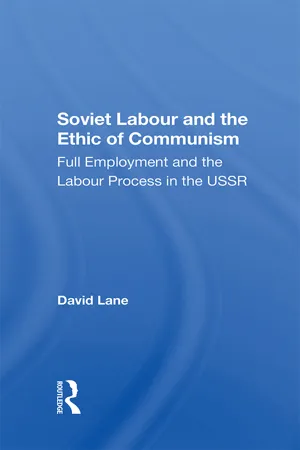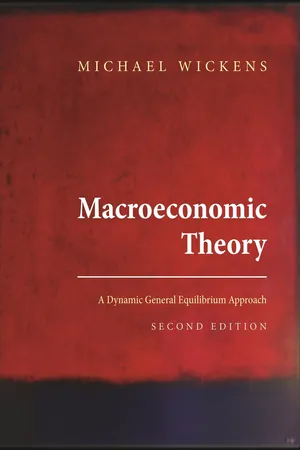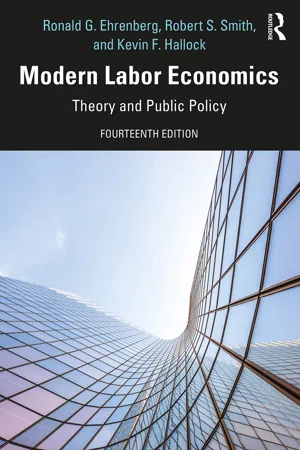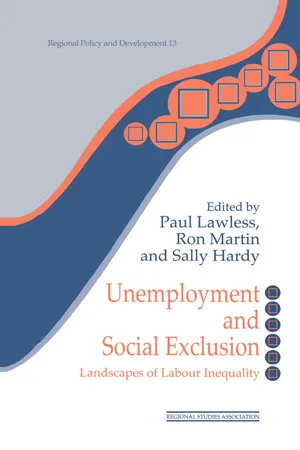Economics
Frictional Unemployment
Frictional unemployment refers to the temporary period of unemployment that occurs when individuals are transitioning between jobs. It is often considered a natural part of a healthy labor market as workers seek better opportunities or employers search for the right candidates. Frictional unemployment can be influenced by factors such as information asymmetry, geographic mobility, and the time it takes to find a suitable job.
Written by Perlego with AI-assistance
Related key terms
Related key terms
1 of 4
Related key terms
1 of 3
8 Key excerpts on "Frictional Unemployment"
- eBook - ePub
Labour Economics
Unlocking the Secrets of Labour Economics, Navigating Work, Wages, and Economic Impact
- Fouad Sabry(Author)
- 2023(Publication Date)
- One Billion Knowledgeable(Publisher)
Seasonal unemployment may be considered a form of structural unemployment because it is associated with particular types of employment (construction and migratory farm work). Using "seasonal adjustment" techniques, the most-cited official measures of unemployment omit this type of unemployment from the statistics. This causes substantial and lasting structural unemployment.The Beveridge curve of 2004 job vacancy and unemployment rate (from the US Bureau of Labor Statistics)Frictional Unemployment is the period of time between jobs during which a worker searches for or transitions to a new position. It is sometimes referred to as search unemployment and, depending on the circumstances of the unemployed individual, may be voluntary. Because jobs and workers are heterogeneous, a mismatch between the characteristics of supply and demand can result in Frictional Unemployment. This mismatch can be caused by a variety of factors, including skills, compensation, work hours, location, seasonal industries, attitude, and taste. New entrants (such as recent graduates) and re-entrants (such as former housewives) can also experience Frictional Unemployment.Workers and employers generally accept a degree of imperfection, risk, or compromise, but not immediately. They will expend some time and effort to find a more suitable companion. This is beneficial to the economy because it leads to a more efficient allocation of resources. However, if the search takes too long and there are too many mismatches, the economy suffers because not enough work is completed. Consequently, governments will seek multiple means to reduce unnecessary Frictional Unemployment, including the provision of education, advice, training, and aid such as daycare centers.The frictions in the labor market are sometimes graphically represented by a Beveridge curve, a concave, downward-sloping curve that illustrates a correlation between the unemployment rate and the vacancy rate. Variations along the curve are caused by shifts in the labor supply or demand. A rise or fall in labor market frictions will shift the curve to the right or left, respectively. - eBook - ePub
- Amal Sanyal(Author)
- 2017(Publication Date)
- Routledge(Publisher)
Some are not interested in a job at that time. We can call them unemployed by choice. This sort of unemployment is more a feature of richer countries where people want to take time off from work once in a while. Second, there are those who have left a job and are looking for another one. They may want a change of location or are looking to improve their career and so on. Their unemployment is called frictional. Frictional Unemployment, like mechanical friction, cannot be eliminated but can be reduced. Better job search mechanisms and skill matching by job exchanges can cut down transit time between jobs and hence Frictional Unemployment. However, some among the frictionally unemployed workers face a challenge. They are those who have lost jobs because of structural changes in the economy. Structural changes occur as some industries recede or die out and new ones come up. As a result, workers in the declining industries lose jobs and look for employment in the emerging industries. This type of unemployment, called structural unemployment, is tougher than other forms of Frictional Unemployment. It requires re-orientation of workers in many ways such as learning new skills and migrating to new industrial centres. It may disrupt the worker’s family and life cycle. There are two other components of unemployment. The first is seasonal fluctuation. In countries with a large agricultural workforce there is huge variation of unemployment reflecting the seasonality of principal crops. The second is a component that moves up and down in tandem with the downs and ups of business called business cycles. Seasonal factors and business cycles contribute large variation to unemployment. Statistical methods are used to separate out the various components from the data on total unemployment. The part that fluctuates within the year with temporal regularity is attributed to seasonal influence. Seasonal influence need not be from agriculture alone - eBook - ePub
Soviet Labour And The Ethic Of Communism
Full Employment And The Labour Process In The Ussr
- David Lane(Author)
- 2019(Publication Date)
- Routledge(Publisher)
1Figure 4.1: Frictional UnemploymentIn market economies, it is usually reckoned that even with full employment, 2-3 per cent of the workforce will remain 'frictionally' unemployed. 'Frictional' unemployment is not usually counted in market economies as giving a person an unemployed status. The length of the period recognized as being 'between jobs', or actively seeking work, makes a great deal of difference to unemployment statistics. People unsuccessfully seeking work for less than four weeks are usually excluded, and in some countries, such as Sweden, the qualifying period is as much as 60 days.2Measurement of Turnover
Frictional Unemployment is the major source on which the rate of unemployment in the Soviet Union has been estimated by western experts. Such estimates are based on extrapolation from data on turnover (tekuchest '). These include people who voluntarily leave or are dismissed, but exclude those who retire, join the armed forces, are transferred to other enterprises or participate in 'organized transfers' (orgnabor ). On such a basis, Mesa-Lago and Peter Wiles have attempted to calculate total Soviet unemployment rates forthe 1950s and 1960s. Mesa-Lago3 calculates that in 1960, 20 per cent of the workforce lost an average of 27 work days as a result of changing jobs: this gives a rate of 'aggregate unemployment' at 3.3 per cent. As Mesa-Lago points out, however, the statistical basis for these calculations has some flaws. Turnover may not have involved any time-lags in some cases and the average days lost may not be representative of the whole: turnover varies enormously between areas4 (see below). Nevertheless, Mesa-Lago concludes that a rate of 2-3 per cent is 'roughly indicative of the importance of Frictional Unemployment in the USSR due to job shifts among industrial workers'.5 Paul R. Gregory, on the basis of interviews conducted in the early 1980s with 2,800 Soviet emigrés living in the United States, estimates that the level of unemployment is 2½ to 3 per cent.6 Peter Wiles, basing his estimate on a 30 calendar day average idleness for a jobchanger in Krasnoyarsk city, calculates a 1.3 per cent Frictional Unemployment rate for the USSR.7 In the Soviet journal Trud in 1974, it was reported that in the RSFSR 3.5 million people in industry and building changed jobs: it was further calculated that this represented a loss of 400,000 person work years. If one expresses this as a proportion of total employment in industry and building one may calculate an annual rate of frictional employment of 1.5 per cent.8 In the Belorussian Republic in 1976/77, it has been calculated that the equivalent of 10-11,000 people were lost to production in industry and building as a result of turnover.9 This represents a loss of under one per cent per year.10 - eBook - ePub
Macroeconomic Theory
A Dynamic General Equilibrium Approach - Second Edition
- Michael Wickens(Author)
- 2012(Publication Date)
- Princeton University Press(Publisher)
To clarify matters it is helpful to distinguish between different types of unemployment. First, involuntary unemployment is where a person is willing to take a job at the going wage but none is available. This is the common meaning of unemployment. It is usually attributed to recessions and it is what traditional Keynesian economics is largely concerned with. Involuntary unemployment is mainly temporary. It varies with the business cycle and largely disappears in booms. Second, Frictional Unemployment is due, for example, to the flow of workers between jobs and the problem of matching job vacancies with those searching for work. The failure to find a match results in unemployment. Such unemployment, although varying over time, is always present. It helps to explain why unemployment is a permanent feature and may exist even when labor markets are in equilibrium and there are unfilled vacancies. Not surprisingly, much of the recent DSGE literature adopts this approach as Frictional Unemployment is easier to incorporate into equilibrium DSGE models than involuntary unemployment. Third is voluntary unemployment: people who claim unemployment benefits but are not seeking work. In effect, they are not offering to supply labor and so are not participating in the labor market. We will therefore regard such people as not being part of the labor force, and hence not unemployed. Nonetheless, it should be said that such people may be looking for work but are unable to find a job that provides a wage higher than the state benefits they receive, meaning that they would be financially worse off if they accepted a job. This situation is more prevalent in Europe than in the United States, where state benefits are generally lower. We also ignore those who work a few hours on a casual or informal basis, either for others or for themselves at home.Continuous labor market equilibrium and clearing, and hence the absence of involuntary unemployment, requires perfectly flexible real wages. It was argued in chapter 9 - eBook - ePub
- D Sapsford(Author)
- 2013(Publication Date)
- Routledge(Publisher)
In cases where the wage ruling in a particular labour market is for some reason above the equilibrium or market-clearing level, there will be an excess of labour supply over labour demand, and the workers comprising this excess supply are said to be involuntarily unemployed, as they are seeking but are unable to attain employment at the prevailing wage rate. 1 TYPES OF UNEMPLOYMENT It is usual to distinguish between several types of unemployment, and the fourfold classification, discussed by Beveridge (1944), of total unemployment into frictional, structural, seasonal and cyclical categories appears at first sight to provide a straightforward subdivision. Frictional Unemployment is the unemployment that results from workers’ moving between jobs. As long as people change jobs, and as long as it takes a finite time to move from one job to another, some positive amount of Frictional Unemployment will exist at any moment in time. Frictional Unemployment is a consequence of the short-run changes in the labour market that constantly occur in a dynamic economy in response to changes in the pattern of demand for, and supply of, goods and services, and it arises because labour supply does not adjust instantaneously to changes in labour demand. Structural unemployment is caused by long-run changes in the structure of the economy, which give rise to changes in the demand for labour in particular industries, regions and occupations, and it arises because, although workers are available for employment, their skill or locations do not match those of unfilled vacancies. The distinction between frictional and structural unemployment is by no means a clear-cut one. While most writers see the distinction as being one of degree rather than kind, with structural unemployment being essentially a longer-term or more stubborn form of Frictional Unemployment, others have sought to clarify the distinction by explicitly considering the nature of unfilled job vacancies. Perlman (1969, p - eBook - ePub
Modern Labor Economics
Theory and Public Policy
- Ronald Ehrenberg, Robert Smith, Kevin Hallock(Authors)
- 2021(Publication Date)
- Routledge(Publisher)
One reason why we might observe a negatively sloped wage curve can be found in the efficiency-wage explanation of structural unemployment reviewed earlier. Suppose, for example, that one cause of long-term unemployment is the widespread payment of above-market wages by employers in an effort to reduce shirking among their employees. In regions where this and other causes happen to create higher levels of unemployment, the efficiency-wage premiums needed to reduce shirking would be lower—which would cause the negative association that we observe between regional unemployment rates and wage levels.Demand-Deficient (Cyclical) Unemployment
Frictional Unemployment arises because labor markets are dynamic and information flows are imperfect; structural unemployment arises because of long-lasting imbalances in demand and supply. Demand-deficient unemployment is associated with fluctuations in business activity (the “business cycle”), and it occurs when a decline in aggregate demand in the output market causes the aggregate demand for labor to decline in the face of downward inflexibility in real wages. Such a decline took place during the Great Recession of 2007 to 2009, during which time the unemployment rate in the United States rose from 4.4 percent in the spring of 2007 to 10 percent in the fall of 2009.35 Another sudden increase in unemployment took place from February to April in 2020, although the sudden rise in the U.S. unemployment rate from 3.5 percent to 14.7 percent was rooted in the abrupt shutdown of businesses and travel to reduce the spread of COVID-19—not the business cycle.Returning to our simple demand-and-supply model of Figure 14.2 , suppose that a temporary decline in aggregate demand leads to a shift in the labor demand curve to D1 . If real wages are inflexible downward, employment will fall to E1 , and E0 −E1 additional workers will become unemployed. This employment decline occurs when firms lay off workers (increasing Peu )36 and reduce the rate at which they replace those who quit or retire (decreasing Pne and Pue - eBook - ePub
Modern Labor Economics
Theory and Public Policy (International Student Edition)
- Ronald G. Ehrenberg, Robert S. Smith(Authors)
- 2017(Publication Date)
- Routledge(Publisher)
Another defines full employment as the rate of unemployment at which job vacancies equal the number of unemployed workers, and yet another defines it as the level of unemployment at which any increases in aggregate demand will cause no further reductions in unemployment. A variant of the latter defines the natural rate as the unemployment rate at which all unemployment is voluntary (frictional and perhaps seasonal). A final definition of the natural rate is that rate at which the level of unemployment is unchanging and both the flows into unemployment and the duration of unemployment are normal. 45 All the various earlier definitions try to define in a specific way a more general concept of full employment as the rate that prevails in “normal” times. If we assume that frictional and seasonal unemployment exist even in labor markets characterized by equilibrium (that is, markets having neither excess demand nor excess supply), it is clear that the natural rate of unemployment is affected by such factors as voluntary turnover rates among employed workers, movements in and out of the labor force, and the length of time it takes for the unemployed to find acceptable jobs. These factors vary widely across demographic groups, so the natural rate during any period is strongly influenced by the demographic composition of the labor force. Unemployment and Demographic Characteristics Table 14.4 presents data on actual unemployment rates for various age/ race/gender/ethnic groups in 2015, a year in which the overall unemployment was a moderate 5.3 percent - eBook - ePub
Unemployment and Social Exclusion
Landscapes of Labour inequality and Social Exclusion
- Sally Hardy, Paul Lawless, Ron Martin(Authors)
- 2013(Publication Date)
- Routledge(Publisher)
Rubery 1992a ). In short, we do not have an active labour market policy which reacts quickly and effectively to employment loss by providing positive signals and direction. The delayed, dilatory response that typifies current policy practice follows directly from the counter-revolution and its emphasis on inflation reduction as the key economic objective. The short-term unemployed and flows into unemployment are assumed to maintain the effective labour reserve. Policies which reduce their numbers would add to inflationary pressure. Labour market policy should thus address flows out of unemployment, and particularly the long-term unemployed because they are so far removed from opportunity that a reduction in long-term unemployment will do little to add to the bargaining power (inflationary threat) of labour. The claim that we should react to those without work only when it is quite clear that loss of opportunity is lasting deserves a direct challenge. Probability of escape from unemployment certainly declines the longer people are without work. With long unemployment, skills deteriorate; the habit of regular work may be lost; the self-respect and self-confidence of the individual and the view of the potential employer change. But it is surely preferable to prevent the flows into unemployment in the first place. A policy approach which develops from the counter-revolution will be hard on the unemployed, but soft on the causes of unemployment. If one wishes to understand – rather than disguise or deny – unemployment, the counterrevolution is not the ideal philosophy.Recognising Unemployment: Regions and Structural Change
Involuntary unemployment is the product of a cumulative process which is triggered by an initial decline in key sectors of the local economy. Modern unemployment takes its characteristic form from the employment relationship within large industrial units. Such employment requires a clear separation between the formal and the informal economy: a clear divide between organised and casual work. When this form of secure employment disappears, a gap or space emerges within the community and around the individual. That gap or space is the essence of unemployment (see Piore 1987 ). It cannot simply be assumed that work is always available to those who are truly flexible; to bridge the gap may require a collective response as well as individual initiative. Experience in work does not necessarily translate into alternative productive activity and without capital, without organisation, the individual and the community lack direction. The unemployment which follows major plant closures and cutbacks is not indicative of a sudden taste for leisure on the part of the workers involved. Neither can it be explained in terms of productive job search.The internal labour market literature (see Doeringer and Piore 1985
Index pages curate the most relevant extracts from our library of academic textbooks. They’ve been created using an in-house natural language model (NLM), each adding context and meaning to key research topics.
Explore more topic indexes
Explore more topic indexes
1 of 6
Explore more topic indexes
1 of 4







